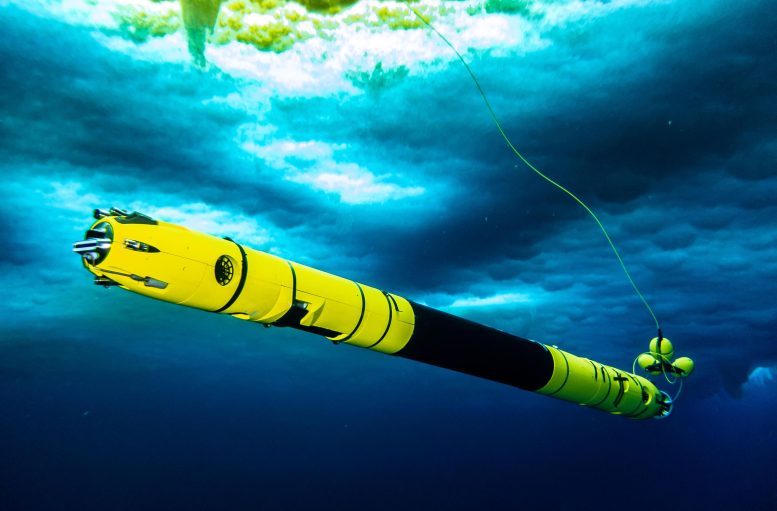
The icefin robot under the ice near McMurdo research station, operated by the US Antarctic Program. Credit: Rob Robbins USAP
Results provide close-up view of melting beneath Antarctic Glacier using underwater robot Icefin.
The rapid retreat of Thwaites Glacier in West Antarctica appears to be driven by different processes under its floating ice shelf than researchers previously understood, a team of scientists has concluded. Its assessment is based on novel observations from where the ice enters the ocean—these show that while melting beneath much of the ice shelf is weaker than expected, melting in cracks and crevasses is much faster. Significantly, despite the suppressed melting, the glacier is still retreating, the researchers note.
Thwaites Glacier is sometimes called the “Doomsday Glacier” because of the potential threat it poses to global sea level rise. The glacier is one of the largest and most rapidly melting glaciers in Antarctica and is located in a region of Antarctica that has been warming at a faster rate than the rest of the continent. Scientists are particularly concerned because the glacier is held back by an underwater ridge, which if lost, could result in the glacier collapsing and raising global sea levels by more than a meter. This would have devastating consequences for coastal cities and communities worldwide, leading to widespread flooding and displacement of millions of people.
“By adding in new observations of incredibly high melting on the western side of Thwaites, a larger and more complete picture of the interaction of the glacier with the world ocean is emerging,” explains David Holland, director of New York University’s Fluid Dynamics Laboratory and NYU Abu Dhabi’s Center for Global Sea Level Change, who is the lead U.S. principal investigator for the project. “The melt rates on the western side are the highest seen anywhere in Antarctica to date and suggests the glacier may now be in retreat.”
The findings, reported in two papers in the journal Nature, provide a vital step forward in understanding how the glacier—the size of the state of Florida—is contributing to future sea-level rise. Specifically, the results show that although melting has increased beneath the floating ice shelf, the present rate of melting is slower than many computer models currently estimate.
A layer of fresher water between the bottom of the ice shelf and the underlying ocean slows the rate of melting along flat parts of the ice shelf. Surprisingly, however, the melting had formed stair-case-like topography across the bottom of the ice shelf. In these areas, as well as in cracks in the ice, rapid melting is occurring.
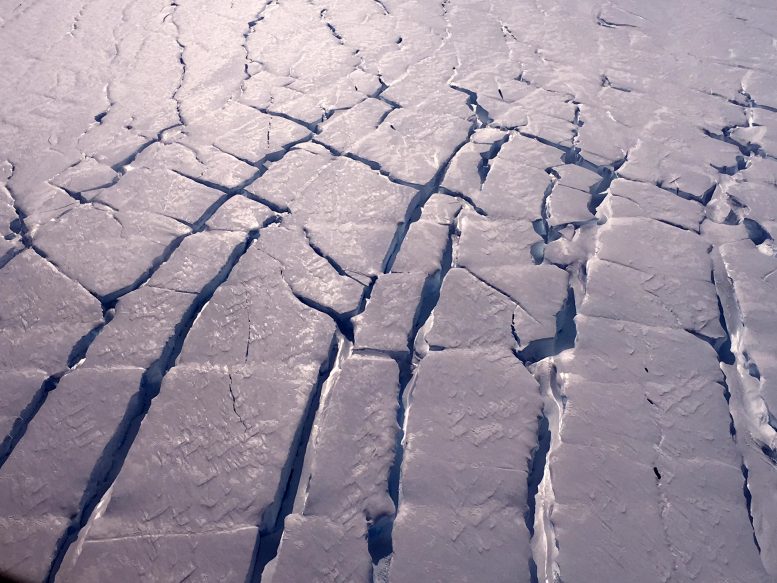
Thwaites Glacier in Antarctica is extremely remote and challenging to get to. Credit: Britney Schmidt
Thwaites Glacier is one of the fastest-changing glaciers in Antarctica: the grounding zone—the point where it meets the seafloor—has retreated 14 kilometers, or more than eight miles, since the late 1990s. Much of the ice sheet is below sea level and susceptible to rapid, irreversible ice loss that could raise global sea-level by over half a meter within centuries.
The new data were collected as part of the MELT project, one of the projects in the U.K.-U.S. International Thwaites Glacier Collaboration, one of the largest international field campaigns ever undertaken in Antarctica. The MELT team undertook observations of the grounding line beneath the Thwaites Eastern Ice Shelf in order to understand how the ice and ocean interacts in this critical region.
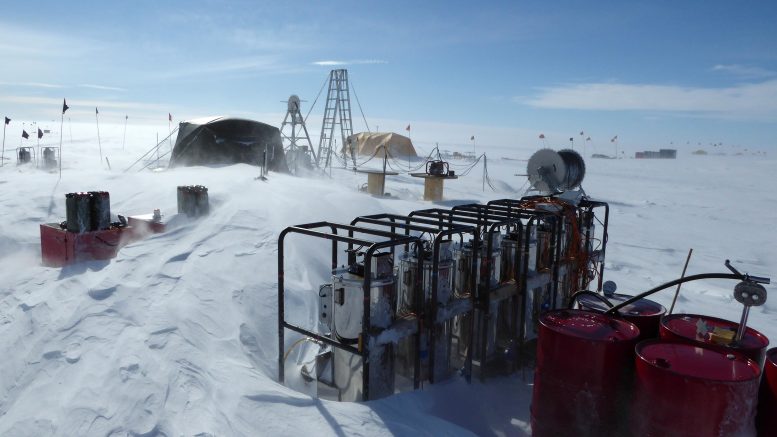
Borehole drilling site on Thwaites Glacier 2022. Credit: Peter Davis – British Antarctic Survey
Peter Davis of the British Antarctic Survey (BAS) took ocean measurements through a 600-meter deep borehole around two kilometers from the grounding line, created by a hot water drill in late 2019. These measurements were compared with melt-rate observations taken at five other sites underneath the ice shelf. Over a nine-month period, the ocean near the grounding line became warmer and saltier but the melt rate at the ice base averaged 2-5 meters per year: less than previously modeled.
“Our results are a surprise, but the glacier is still in trouble,” says Davis, lead author of one of the Nature papers. “If an ice shelf and a glacier is in balance, the ice coming off the continent will match the amount of ice being lost through melting and iceberg calving. What we have found is that despite small amounts of melting there is still rapid glacier retreat, so it seems that it doesn’t take a lot to push the glacier out of balance.”
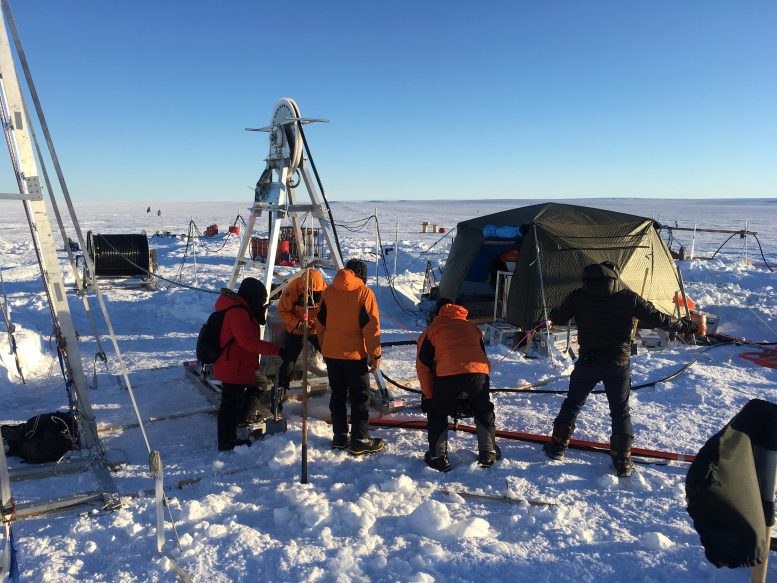
BAS team deploying the hot water drill at Thwaites Glacier including Paul Anker, Keith Nicholls, James Smith and Peter Davis. Credit: Icefin/ITGC/Schmidt
Britney Schmidt, part of faculty at Cornell University’s Astronomy and Earth and Atmospheric Sciences, and a team of scientists and engineers deployed a robot called Icefin through the 600-meter deep borehole. The vehicle is designed to access such grounding zones that were previously almost impossible to survey. The observations Icefin made of the seafloor and ice around the grounding zone provide more detail on the picture of how melting varies beneath the ice shelf. They found the staircases, called terraces, as well as crevasses in the ice base are melting rapidly.
Melting is especially important in crevasses, as water funnels through them heat and salt can be transferred into the ice, widening the crevasses and rifts. Although the vertical melting along the base of the ice shelf was less than expected, melting along sloped ice in these cracks and terraces is much higher and may be a significant factor in ice loss across Thwaites Glacier, especially as major rifts are progressing across the ice shelf.
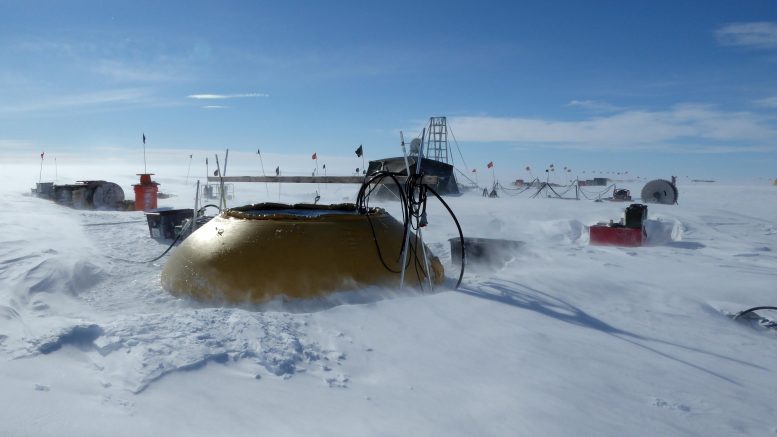
The MELT team melted large amounts of snow to create the hot water to drill through Thwaites Glacier to reach the ‘grounding line’. Credit: Peter Davis
“These new ways of observing the glacier allow us to understand that it’s not just how much melting is happening, but how and where it is happening that matters in these very warm parts of Antarctica,” says Schmidt, the lead author of one of the Nature papers. “We see crevasses, and probably terraces, across warming glaciers like Thwaites. Warm water is getting into the cracks, helping wear down the glacier at its weakest points.”
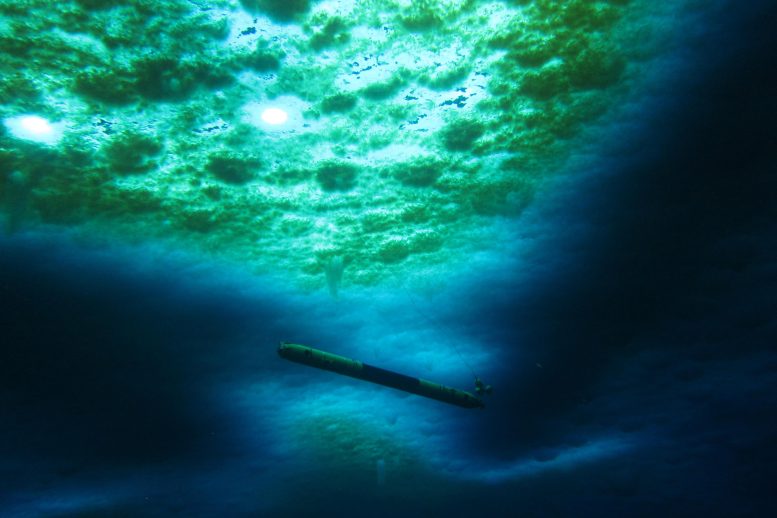
Picture of Icefin operating under the sea ice near McMurdo Station. Credit: Icefin/NASA/PSTAR RISE UP/Schmidt/Lawrence
In January 2020, Holland, a professor at NYU’s Courant Institute of Mathematical Sciences and a co-author of the Nature papers, put together a U.S. team of five institutions—Penn State, the University of Kansas, the University of California, Irvine, Georgia Tech, and NYU—and deployed it to the Thwaites Eastern Ice Shelf. Using ocean mooring and the Icefin robot, they found relatively modest melting. He redeployed the scientists to western Thwaites two years later—aboard the South Korean icebreaker Araon. There, the melt rate was determined to be significantly larger than that observed on the eastern side.
For more on this research, see Doomsday Glacier Is “In Trouble.”
References:
“Heterogeneous melting near the Thwaites Glacier grounding line” by B. E. Schmidt, P. Washam, P. E. D. Davis, K. W. Nicholls, D. M. Holland, J. D. Lawrence, K. L. Riverman, J. A. Smith, A. Spears, D. J. G. Dichek, A. D. Mullen, E. Clyne, B. Yeager, P. Anker, M. R. Meister, B. C. Hurwitz, E. S. Quartini, F. E. Bryson, A. Basinski-Ferris, C. Thomas, J. Wake, D. G. Vaughan, S. Anandakrishnan, E. Rignot, J. Paden and K. Makinson, 15 February 2023, Nature.
DOI: 10.1038/s41586-022-05691-0
“Suppressed basal melting in the eastern Thwaites Glacier grounding zone” by Peter E. D. Davis, Keith W. Nicholls, David M. Holland, Britney E. Schmidt, Peter Washam, Kiya L. Riverman, Robert J. Arthern, Irena Vaňková, Clare Eayrs, James A. Smith, Paul G. D. Anker, Andrew D. Mullen, Daniel Dichek, Justin D. Lawrence, Matthew M. Meister, Elisabeth Clyne, Aurora Basinski-Ferris, Eric Rignot, Bastien Y. Queste, Lars Boehme, Karen J. Heywood, Sridhar Anandakrishnan and Keith Makinson, 15 February 2023, Nature.
DOI: 10.1038/s41586-022-05586-0
The mission, established in 2018, forms part of the International Thwaites Glacier Collaboration (ITGC), a five-year, $50 million joint U.S. and U.K. mission to learn more about Thwaites Glacier, its past, and what the future may hold.
The research was supported by the U.K.’s Natural Environment Research Council and the U.S. National Science Foundation (1739003, 1929991).

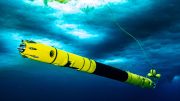
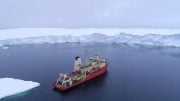
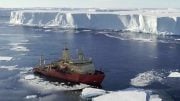
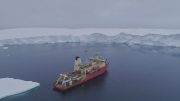

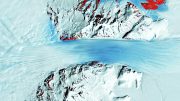
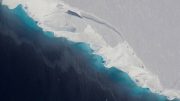

Be the first to comment on "Exploring the Secrets of the Doomsday Glacier: Underwater Robot Reveals Novel Processes Behind its Rapid Retreat"